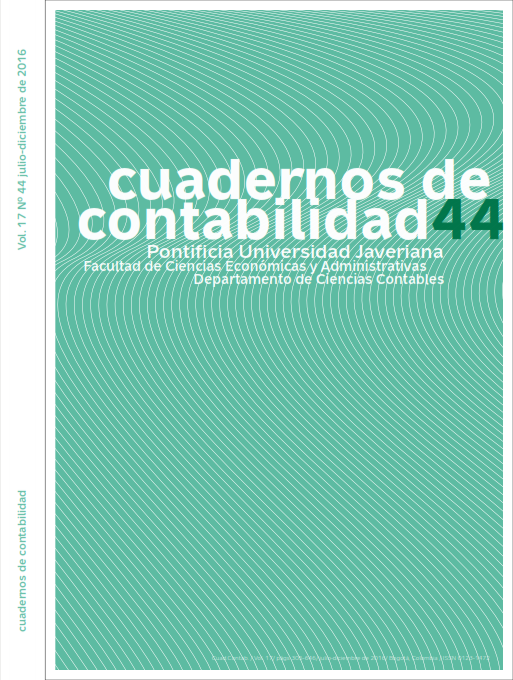Resumen
Este documento pretende resaltar la creciente importancia que para la profesión contable tienen el conocimiento y el continuo aprendizaje de conceptos profundos de finanzas y riesgos. Mediante un análisis económico-contable de los ajustes por riesgo de crédito de contraparte y propio propuestos por la IFRS 13, el autor pone de manifiesto debilidades recurrentes en los procesos de emisión y aplicación de normas contables que deben ser atendidos como desafíos propios de la profesión a corto y mediano plazo para garantizar que no se desvirtúe la esencia económica y financiera de la contabilidad. Se concluye que tener estándares políticamente fuertes pero técnicamente mal elaborados es servir a intereses diferentes a losfinancieros y para la toma de decisiones. La contabilidad debe imitar la complejidad de las transacciones y no ocultar realidades como aparente solución a los problemas.
Colombia (2009). Ley 1314 de 2009, por la cual se regulan los principios y normas de contabilidad e información financiera y de aseguramiento de información aceptados en Colombia, se señalan las
autoridades competentes, el procedimiento para su expedición y se determinan las entidades responsables de vigilar su cumplimiento, Diario Oficial, 47.409, 13 de julio de 2009. Disponible en: http://www.
secretariasenado.gov.co/senado/basedoc/ley_1314_2009.html
Comité de Supervisión Bancaria de Basilea (2001). El Nuevo Acuerdo de Capital de Basilea. Disponible en: http://www.bis.org/publ/bcbsca03_s.pdf
Financial Accounting Standard Board, FASB (2006). Fair Value Measurements. Statement of Financial Accounting Standards 157. Disponible en: http://www.fasb.org/cs/BlobServer?blobcol=urldata&bl
obtable=MungoBlobs&blobkey=id&blobwhere=1175820927537&blobheader=application%2Fpdf
Gregory, Jon (2012). Counterparty Credit Risk: A Continuing Challenge for Global Financial Markets. London: John Wiley & Sons Ltd.
Hull, John & White, Alan (2014). Valuing Derivatives: Funding Value Adjustments and Fair Value. Financial Analysts Journal, 70 (3), 46-56. Disponible en: http://www-2.rotman.utoronto.ca/~hull/downloadablepublications/FVAandFairValue.pdf
International Accounting Standard Board, IASB (June 2009). Credit Risk in Liability Measurement. Disponible en: http://www.ifrs.org/Current-Projects/IASB-Projects/Credit-Risk-in-Liability-Measurement/DP-Jun-09/Documents/CreditRiskLiabilitStaff.pdf
International Accounting Standards Board, IASB (2011). IFRS 13: Fair Value Measurement. Disponible en: http://www.ifrs.org/Current-Projects/IASB-Projects/Fair-Value-Measurement/IFRS-13-Fair-Value-Measurement/Pages/IFRS-13-Fair-Value-Measurement.aspx
International Accounting Standards Board, IASB, Expert Advisory Panel (2009). Medición y revelación del valor razonable de instrumentos financieros en mercados que ya no están activos. En Samuel Alberto Mantilla (comp., trad.). Contabilidad a valor razonable: en el contexto de la crisis actual de los mercados, 133-218. Bogotá: ECOE Ediciones.
Martínez-Pineda, Pablo Enrique (2010). Una dificultad inherente de la profesión analizada desde el punto de vista de la medición. Revista Estudiantil Identidad Contable, 1 (1), 77-89.
Merton, Robert C. (1974). On the Pricing of Corporate Debt: The Risk Structure of Interest
Rates. Journal of Finance, 29 (2), 449-470.
Morales-Díaz, José (2010). Pasivos financieros a valor razonable: la consideración del propio riesgo de crédito. Foro AECA Instrumentos Financieros (FAIF). Disponible en: http://aeca.es/old/faif/articulos/comunicacion5.pdf
Ramírez, Juan (2015). Accounting for Derivatives: Advanced Hedging under IFRS 9. London: John Wiley & Sons Ltd.
Ryan, Stephen (2008). Fair Value Accounting: Understanding the Issues Raised by the Credit
Crunch. Disponible en: http://www.cii.org/files/publications/white_papers/07_11_08_fair_value_accounting.pdf
United States, Security and Exchange Commission, SEC, Office of the Chief Accountant, Division of
Corporation Finance (2008). Report and Recommendations Pursuant to Section 133 of the Emergency Economic Stabilizing Act of 2008: Study on Mark-to-Market Accounting. Disponible en: https://www.sec.gov/files/marktomarket123008.pdf
El aval sobre la intervención de la obra (revisión, corrección de estilo, traducción, diagramación) y su posterior divulgación se otorga mediante una licencia de uso y no a través de una cesión de derechos, lo que representa que la revista y la Pontificia Universidad Javeriana se eximen de cualquier responsabilidad que se pueda derivar de una mala práctica ética por parte de los autores. En consecuencia de la protección brindada por la licencia de uso, la revista no se encuentra en la obligación de publicar retractaciones o modificar la información ya publicada, a no ser que la errata surja del proceso de gestión editorial. La publicación de contenidos en esta revista no representa regalías para los contribuyentes.


